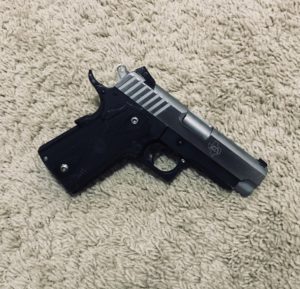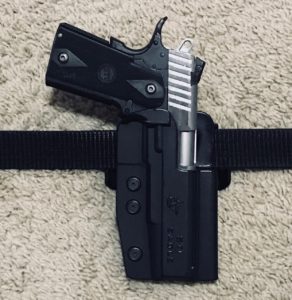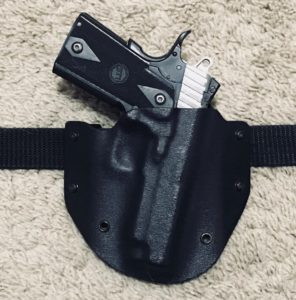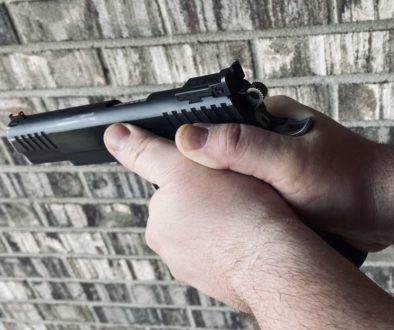Draw Speed – How much does equipment matter?
Draw Speed- How much does equipment matter?
Since Applied Ballistics sells competition gear at the store, has a sponsored shooting team, and hosts USPSA competitions at the indoor range it should come as no surprise that we are often asked just how much of a difference buying high end competition gear makes compared to using “normal” defensive carry equipment when shooting competitively. Most people start out shooting some form of competition with the equipment they already have, which is actually exactly what I recommend for someone wanting to try out the shooting sports. After a bit of time, however, they usually start looking at fancier equipment and the inevitable question comes up: how much faster will this holster (or gun, or magazine carrier, or insert-expensive-shiny-new-gear-here) make me?
While I have always answered this question to the best of my ability, I was always speaking about my opinion rather than hard evidence. While I certainly shoot faster now than I did a few years ago, and I now use high end competition gear whereas a few years ago I used my day to day carry gear, I couldn’t really quantify how much of that difference was practice and experience vs how much was high end equipment.
With that in mind, I decided I wanted to find out just how much difference in raw speed one could expect by improving their gear. I needed something measurable to test so I settled on testing draw speed using different holster types and cover garments.
The Gear
First, this wasn’t a test between gear of similar type to see which brand was better, it was a test of different types of gear. I wanted to test a concealed carry holster vs a well set up IDPA holster vs a full tilt USPSA race holster. I also wanted to test two different types of cover garments as they would relate to concealed carry and to IDPA competition, one a basic street shirt and one a competition vest.

I needed to minimize variables so one of my first tasks was to decide on a gun. I had to find a single pistol that would work in all three types of holster while being something I was familiar with and comfortable shooting at full speed. I didn’t want the type of pistol to affect my speed when testing. For several reasons I settled on an STI Guardian DS 2011. For starters, I have more rounds down range over the last three years on the 2011 platform than any other handgun (I just passed 12000 rounds so far this year through various 2011s). I didn’t want to use one of my actual competition guns, however, since I didn’t have a true concealed carry setup that would work. The Guardian is a gun I carry on a regular basis (both concealed out in public and open when I’m at work), I shoot the gun regularly, it feels very similar to my competition 2011s, and I am very comfortable with it. It is a double stack 1911, like my competition 2011s, but it is just a hair bigger than a Glock 19, making it a good carry size pistol. The final factor, and possibly the most important, was that I had holsters of all three types that would fit this specific pistol.
For gear to test I chose three holsters and two cover garments. Again I went with gear that I use regularly and am comfortable with. I didn’t want to use a carry holster I had never drawn from and then use my own competition rig as that would skew the results. The holsters I chose were a DAA Racemaster, a Comp-Tac International, and a custom pancake kydex holster made for me by Applied Ballistics. The cover garments were a Blackhawk WarriorWear shirt and a 5.11 Tactical shooting vest.

The DAA Racemaster holster, which I use in USPSA and Multigun with a variety of 2011s, is every inch a bona fide race holster. It is completely open, only covering the trigger guard, and it rides low with a slight rearward cant. When it is locked, you couldn’t remove the gun without unlocking it, breaking the holster, or breaking the gun. When unlocked it requires only a few ounces of pressure and ¼” of movement in the right direction and it is completely unencumbered. I used this holster on the same belt I use when I compete, a DAA Premium Race Belt. This belt is very rigid and works well with a low holster like the Racemaster, preventing the low ride of the holster from causing it to twist and bind during the draw.

The Comp-Tac International is the middle ground. It is the most popular holster in IDPA and happens to be the one I use when shooting IDPA. It is usable as a concealed carry holster, and I have used it as one, but it isn’t as easily hidden as other models because it doesn’t hug the body as tightly. The International has all the features that make it just barely legal in IDPA. It has the front cut out to just below the ejection port, it sits just about as far off the belt as it legally can, and the tension is adjustable from hard-to-remove all the way down to the-gun-is-sitting-loosely-in-a-cup-holder. For this testing I left the tension set exactly how I have it when shooting IDPA, which means just enough resistance to prevent the gun from bouncing out during movement while requiring minimal force to pull the gun up and free from the holster. I wouldn’t want to fight someone or jump a fence with the holster set to the tension I use for IDPA, but I have no concerns with the gun coming out as long as I remain upright. It is also worth mentioning that this holster can be set to vertical or FBI cant. I compete with it vertical, so I kept it that way for testing, but if the holster were to be used for concealment the forward cant would improve concealability. For a belt I used my Nexbelt Titan Tactical, the same belt I use when competing with this holster in IDPA.

The custom kydex holster is one that Applied Ballistics made specifically for concealed carry to my specifications. It has about a 9 degree forward cant (about half what most call the FBI cant), it hugs the body to minimize the profile when worn under a cover shirt, and the tension is set fairly high. The Guardian, which isn’t exactly a small gun at a hair bigger than a Glock 19, disappears under a cover garment with this setup. The cant is sufficient to tuck the grip in and the gun is close enough to my body that it creates minimal printing. The tension is tight enough that it requires a deliberate effort to remove, but isn’t so tight that the act of drawing upsets my belt or waistline. It is, to me, the perfect balance for a concealed carry rig. I also used the Nexbelt with this holster, since it is also the belt I wear every day to carry concealed.
As for the cover garments, the Blackhawk shirt is a bit heavier fabric than most shirts of its type. This makes it nice for drawing from concealment while being a shirt that I can wear daily. In fact, it is one of the cover shirts I wear most frequently when out and about on my daily routine.
The 5.11 Tactical vest is the vest I use in IDPA. It is a “shoot me first” vest that tells others that the wearer is carrying a gun, and that gun is probably a full size pistol with a few spare magazines. Still, the fabric is thicker and stiff enough to make the draw quicker and more consistent than a standard shirt like the Blackhawk.
The Testing Method
I wanted to evaluate draw speed and nothing else. In order to do this I had to have something measurable while minimizing variables. I decided on using a shot timer to measure time between a start signal and one shot on a steel B-C zone target at a measured 10 yards. I only used a single shot because I didn’t want the results to reflect my split times. Adding a second shot would simply introduce another variable.
I shot all of the various gear combinations on the same day, in the same lighting, with the same wind, from the same shooting position, against the same target, wearing the same clothes, using the same hearing protection, and wearing the same two loaded 17 rounds mags on the support side to offset weight on the belt. The only thing that I changed was the specific gear I was testing. I shot at 1pm with the sun almost directly overhead, it was 79 degrees, and there was a slight breeze from directly behind me while on the firing line. It was a beautiful day and a perfect day to shoot without any environmental factors to worry about.
I shot each combination, as well as the control (low ready), ten times. I only loaded one round into the gun, so the weight didn’t change during a string of fire. If I pushed too hard and missed the target, that time was discarded. I didn’t want to skew the results by counting wild shots that were made too early from me trying to push time. I shot each combination as quickly as I could draw and obtain a sight picture sufficient to make the shot. In the end I had only 4 shots that were tossed out because they were misses and 80 shots on target that were scored. I believe this is a fairly accurate representation of the times I can make consistent first shot hits on a moderate sized target at close range.
Results
The results here are listed from the slowest combination to the fastest. I used the averages but also provided the fastest and slowest times for reference.
Custom Kydex Holster / Blackhawk Cover Shirt: 1.67 Seconds
The slowest combination of the bunch was the one I expected it to be, the custom Kydex concealment holster paired with the Blackhawk cover shirt. The concealment holster was made with concealed carry rather than competition in mind. The Blackhawk shirt was only slightly different than a shirt you would find a normal store and is used for concealment specifically because it does not stand out in a public setting. After ten shots my slowest recorded time was 1.82 seconds while my fastest was 1.55 seconds. My average was 1.67 seconds. I don’t consider drawing and making a good hit at 10 yards in 1.67 seconds with what I wear daily a bad standard. With decent split times getting two good hits on a threat in under two seconds should be no problem.
Comp-Tac International / Blackhawk Cover Shirt: 1.58 Seconds
The next slowest combination from my testing was the Comp-Tac International holster paired with the Blackhawk cover shirt. Before the test I wasn’t sure which would slow me down more, the concealment holster or the cover shirt. As it turns out, the cover garment made a larger difference for me. It was 0.09 seconds faster on average than the custom Kydex holster using the same cover shirt, with the average being 1.58 seconds. The slowest time was 1.78 seconds while the fastest was 1.41 seconds.
Custom Kydex Holster / 5.11 Competition Vest: 1.51 Seconds
Next up was the custom Kydex concealment holster paired with the 5.11 Competition Vest. With an average time of 1.51 seconds, this means that switching from the Blackhawk shirt to the 5.11 Vest shaved 0.16 seconds from the draw. That seems fairly significant to me and should be significant to anyone serious about shooting IDPA competition where a cover garment is required. I don’t see myself wearing one of these vests in public for reasons already stated (they are called “shoot me first” vests for a reason) but I can’t deny that they make presentation from the holster quicker. The fastest shot in this string was 1.45 seconds while the slowest was 1.54 seconds with the average being 1.51 seconds.
Comp-Tac International / 5.11 Competition Vest: 1.40 Seconds
Pairing the Comp-Tac International with the 5.11 Vest resulted in a 1.40 second average, shaving 0.18 seconds off of the same holster using the Blackhawk shirt. Again, it appears that the vest saves significant time. When comparing this, which is a good IDPA setup, with my every day carry equipment the combination of the vest and holster shaved 0.27 seconds off of my draw time. If we look at using the same cover shirt, but switching between holsters this combo was 0.11 seconds faster than the custom Kydex holster and the 5.11 Vest. Pretty close to the 0.09 seconds the Comp-Tac saved over the custom Kydex when using the Blackhawk shirt. Here the fastest shot was 1.35 seconds while the slowest was 1.48 seconds.
Custom Kydex Holster / No Cover Garment: 1.27 Seconds
Using the custom Kydex holster without a cover garment averaged 1.27 seconds, which was a full 0.40 seconds faster than using this holster with the Blackhawk shirt and 0.14 seconds faster than with the 5.11 Vest. It was also faster than the Comp-Tac holster was with either cover garment. I managed a fastest shot of 1.15 seconds with this combo, while my slowest was 1.40. This clearly shows that drawing without a cover garment is faster than with one, which is often cited by proponents of open carry.
Comp-Tac International / No Cover Garment: 1.12 Seconds
The next combination in line was the Comp-Tac International with no cover garment. It was an average of 0.15 seconds faster than the custom Kydex holster when no cover garment was used. One point of interest is that I noticed the difference between the custom Kydex Holster and the International were greater when no cover garment was used. It saved 0.09 seconds with the Blackhawk shirt and 0.11 seconds with the 5.11 Vest but jumped to 0.15 seconds with no cover at all. I suspect that the added speed is offset somewhat by having to clear the cover garment a bit wider due to the International sitting a bit further away from the body. In this test my fastest time was 1.05 seconds while my slowest was 1.17 seconds.
DAA Racemaster / No Cover Garment: 1.04 Seconds
Not surprisingly the fastest holster was the DAA Racemaster. It is, after all, a purpose built race holster. It only shaved 0.08 seconds off of my times with the Comp-Tac international but it was also the only holster I was able to get a sub 1 second time with. My fastest time with the DAA was 0.92 seconds while my slowest was 1.13 seconds.
I want to note that I didn’t test the DAA Racemaster with a cover garment for several reasons. First, this holster is not legal in shooting sports that require a cover garment. Second, this holster is not designed for or reasonable to use for concealed carry. It lets go of the gun too easily when unlocked yet if you forget to deactivate the lock it makes drawing the gun practically impossible. Last but not least, with the holster in the unlocked position as it should be at the buzzer the possibility of accidentally snagging the gun with the cover garment and dropping a loaded pistol made testing the holster in this manner an unnecessary risk. There was simply no good reason to do it.
Control, Low Ready: 0.49 Seconds
To have a control for this test I also shot a string from the low ready. The handgun was in the same condition (cocked, chambered, safety on) as it was during all of the other testing. I used a marker at 5 yards to have the muzzle pointed down and at the signal I simply raised the gun, acquired my sights, and fired. My average time from the low ready was 0.49 seconds, over a full half second faster than my average draw from the fastest holster. My fastest shot from the low ready was 0.43 seconds and my slowest was 0.55 seconds.
Conclusions
If we simply look at holsters without cover garments it would appear that the fastest holster is the DAA Racemaster, which was 0.08 seconds faster than the Comp-Tac. Likewise, the Comp-Tac was 0.15 seconds faster than the custom Kydex holster. This means that the DAA Racemaster was 0.23 seconds faster than the custom Kydex, on average.
While this may not seem like a huge difference consider the following scenario. If a shooter was competing in a level II Steel Challenge match that had all 8 standardized stages that means there are 31 scored draws on the clock in a single match. That means that at the end of the day the difference between the DAA Racemaster and the Comp-Tac International is 2.48 seconds. It is not uncommon to view the results of such a match and see that the top ten competitors are normally within a couple seconds of each other so a difference like that can make a significant difference in the final standing.
In this same scenario if you compare the DAA Racemaster with the custom Kydex holster the difference is 0.23 seconds per draw. That adds up to a whopping 7.13 seconds over the course of the entire match.
Likewise, looking at an IDPA match if you go from the custom Kydex holster with a street garment to the Comp-Tac with the 5.11 Vest you potentially gain 0.27 seconds per draw. There are certainly fewer draws in the IDPA match compared to the Steel challenge match but a 10 stage high level IDPA match means 2.70 seconds gained. Again, it isn’t uncommon for competitors to be within a couple seconds of each other at the end of the match.
In the end, whether these incremental gains are worthwhile depends on what your skill level is, how serious you want to be about competition, and how much money you want to spend. For example the DAA Racemaster is well over double the price of the Comp-Tac International, and it can only be used in a few divisions in some of the shooting sports. As with most things, the gains get smaller as the price increases but if you want the best gear you can get then you have to pay for it. I would not suggest a holster like the DAA for someone just starting out in shooting sports, but if you are getting into competition shooting like USPSA or Multigun in a serious way that performance margin may be worth the price. Only you can decide that. Hopefully this information will help you make an informed decision.



